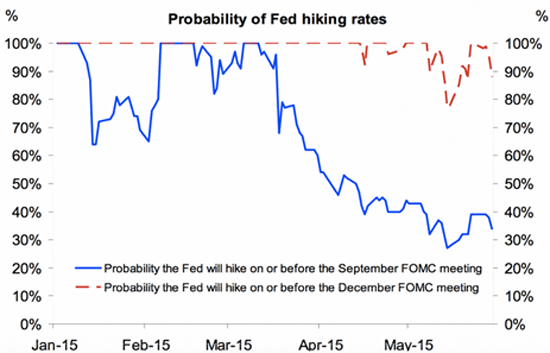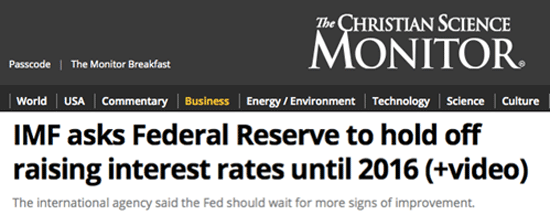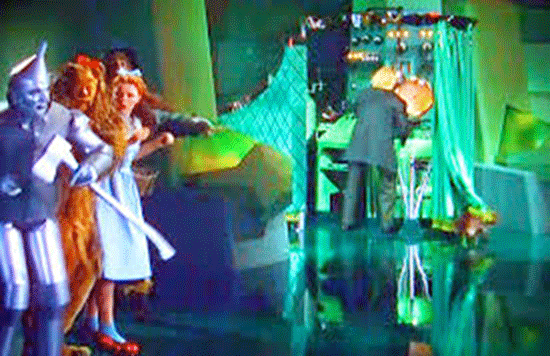2006.
The last time the Federal Reserve raised interest rates was way back in June of 2006. Moreover, the Fed has kept interest rates near 0% since 2008.

But after the June 17 FOMC meeting, just about everybody—and I mean everybody—is assuming that the Federal Reserve will raise interest rates later this year.
The Fed has been so convincing that the market sees a 34% probability for a rate hike by September and an overwhelming 88% probability for a rate hike before or in December.
Heck, even Fed Chairperson Janet Yellen has said that she expects the Fed to raise rates in 2015.
Frankly, I don’t trust the Fed to do anything right, so my prediction is that Janet Yellen and her Fed buddies should not and will not raise interest rates this year.
Hey, I’m not the only person who thinks so.
The International Monetary Fund (IMF) says the FOMC better not raise interest rates this year. The IMF urged the Federal Reserve to delay a rate increase because of a still-struggling US economy and warned of “significant uncertainties as to the future resilience of economic growth.”

IMF Chairperson Christine Lagarde didn’t pull any punches:
“Higher US policy rates could still result in a significant and abrupt rebalancing of international portfolios with market volatility and financial stability consequences that go well beyond US borders.”
“Asset price volatility could last more than just a few days and have larger-than-anticipated negative effects on financial conditions, growth, labor markets, and inflation outcomes.”
“We think that there is a case for waiting to raise rates until there are more tangible signs of wage or price inflation than are currently evident. So, in other words, we believe that a rate hike would be better off in early 2016.”
The IMF sees a very different world than the Federal Reserve, though.
Fed-Speak: The Fed reiterated in its most recent policy statement that it needs to be “reasonably confident” that inflation will move back up to the Fed’s 2% target.
IMF-Speak: The IMF said it doesn’t see inflation reaching that level until mid-2017. Given the “significant uncertainty around inflation prospects, the degree of slack and the neutral policy rate, there is a strong case for waiting to raise rates until there are more tangible signs of wage or price inflation.”
Fed-Speak: Yellen and other Fed officials have been clear that the timing of the first increase is less important than the promise that any rate increases will be shallow.
IMF-Speak: The IMF warned that a rate increase could trigger “significant and abrupt rebalancing of international portfolios with market volatility and financial stability… asset price volatility could last more than just a few days and have larger-than-anticipated negative effects.”
The IMF’s comments are very unusual because they include a precise recommendation about a very important US policy measure, but also because the IMF is poking its nose where it doesn’t belong.
It was bad enough when the United Nations tried to dictate US foreign policy, and now the IMF is trying to influence US monetary policy.
My advice to the IMF and United Nations? Butt out!
However, the IMF is closer to being right than Janet Yellen because our economy is far from healthy.
The Commerce Department revised first-quarter GDP numbers to a negative 0.7%, and consumer spending was up a sluggish 1.8% during the same time frame.
Those weak numbers prompted both the IMF and the Organization for Economic Cooperation and Development (OECD) to lower their growth estimates for the US economy.
- The OECD has slashed its US growth forecast from 3.1% to 2% for 2015.
- Even the Federal Reserve turned more cautious, lowering its growth forecast from 3% to a range of 2.3% – 2.7% in March.
So what’s the Federal Reserve going to do?
Perhaps the Fed has painted itself into such a tight corner with all its tough talk that it has no choice but to raise interest rates before the end of this year.
If that’s the case, however, I expect the FOMC to raise interest rates by so little that it may feel like a mosquito bite. I’m talking about a 5 to 10 basis point increase.
The reason is simple: The US dollar has risen by more than 20% against both the euro and the Japanese yen since June 30, 2014 and the IMF has warned that further appreciation of the dollar would be harmful to the US economy.

The US trade deficit soared to $51 billion, its widest gap since 2008, because the strong dollar made US exports more expensive. Exports fell by 14%, the largest decline in six years.
This bulging trade deficit is the main reason that the US economy shrank by 0.7% in the first quarter.
The Fed hasn’t admitted such, but it understands that a rate increase would push the US dollar even higher and create more of the same trade deficit-induced drag on our economy.
That is why we won’t see anything other than a tiny, tiny face-saving rate increase… or nothing at all.
My advice is to pay no attention to the lady (come on, you got to admit that Janet Yellen sort of looks like the Wizard of Oz from the backside) behind the Federal Reserve curtain. Her tough interest rate talk is all false bluster and misdirection.

If you’re an income-focused investor, you should take the Washington Post’s advice and realize that the rules of successful income investing have changed.

And that you need to change too… unless you can survive on 0.5% interest rates.
I just recommended a stock to my Yield Shark subscribers that’s the epitome of “doing something smart.” It’s paying a 2% dividend right now—not all that exciting, you might say…
BUT its dividends have risen so consistently that had you bought shares 15 years ago, your “dividend on acquisition” (i.e., today’s dividends as a percentage of what you actually paid for the stock) would now be an astonishing 14.6% per year. Combine equity appreciation and dividends, and you end up with a total return of 502.97% over 15 years. Not too shabby, if you ask me.
This is a company with an in-demand product that’s doing everything right, and you can get it at a great price right now. So if you’re looking for both high yield and share price appreciation, this is a good place to start.

Tony Sagami
30-year market expert Tony Sagami leads the Yield Shark and Rational Bear advisories at Mauldin Economics. To learn more about Yield Shark and how it helps you maximize dividend income, click here. To learn more about Rational Bear and how you can use it to benefit from falling stocks and sectors, click here.

